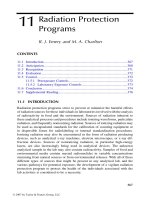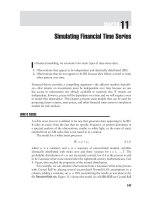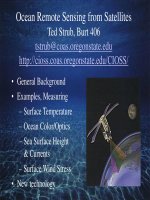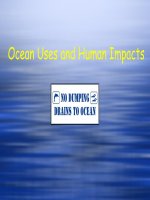Geography and Oceanography - Chapter 11 pot
Bạn đang xem bản rút gọn của tài liệu. Xem và tải ngay bản đầy đủ của tài liệu tại đây (2.74 MB, 37 trang )
Midterm #1 results
posted early next week
see BlackBoard
Answer Keys for both White and Blue exams
will be provided on course website
Scantrons will be returned in labs next week
Physical and Chemical
Structure of the Ocean
Why are the oceans blue?
How is sound transmitted in the ocean?
Why is the ocean “layered” in many locations?
How do you keep your beer cool in the tropics?
Light Absorption in Water
Intensity decreases
rapidly with depth
Blue and green
penetrate deepest,
giving the ocean its
color
Why do objects lose their
color with depth?
✦
The colors other than blue (and
green) are absorbed by the water
molecules in the first few meters
only blue (and green) are reflected
Sound in Sea Water
✦
Sound is transmitted better in water than
Sound is transmitted better in water than
it is in air
it is in air
✦
Sound velocity in the ocean is about 1500
Sound velocity in the ocean is about 1500
m/s, or about 4 times its speed in air
m/s, or about 4 times its speed in air
✦
Sound velocity increases with pressure and
Sound velocity increases with pressure and
temperature
temperature
SOFAR Sound Channel
✦
Sound is focused into the SOFAR channel
because it is a low velocity region
✦
Sound is transmitted best through this
channel good for whales and submarines
(e.g., “Hunt for Red October”)
Heard Island Experiment
Global Warming faster velocity??
Go to Sounds
Ocean Temperature
Solar Heating
➨
Uneven heating of
Earth’s surface
➨
Release of heat as
infrared radiation
➨
Requires flow of
heat by oceans and
atmosphere
➨
Surface circulation
Global Heat Budget
heat at the Earth's
surface (342 W/m
2
)
is supplied by
absorption of
‘short-wave’ solar
radiation from the
sun.
heat lost from
Earth is through
long-wave radiation
back to space.
The Greenhouse Effect
✦
The Atmosphere is transparent to
sunlight (ultraviolet [UV] and visible)
✦
Clouds absorb or reflect about half
✦
Sunlight heats the Earth’s surface, which
then radiates energy as longer wavelength
energy (infrared)
✦
This energy is trapped by the atmospheric
gases (CO
2
, H
2
O, CH
4
)
Special Properties of Water
✦
RECALL:
Melting and boiling points are very high
Highest heat capacity of common liquids
High heat of fusion and vaporization
Sea Surface Temperatures
only 0°-30°C world-wide
Land:
50°C to -50°C
Local Annual Heat Budgets
Amount of solar energy captured at one location
on the Earth varies with season
Local Annual Heat Budgets
Amount of solar energy captured at one location
on the Earth varies with season
Where we live
Temperature (vertical profile)
Seasonal
changes in
temperature
profile
Temperature (vertical profile)
Cool drinks go
here
Thermocline
Temperatures with Depth
✦
Thermocline sharp temperature change
Evaporation - Precipitation
✦
Over the oceans, evaporation exceeds
precipitation
✦
The balance is restored by rain over
the continents, returning water via
rivers
Evaporation vs Precipitation
Climate Belts
Ocean Surface Salinity
Salinity Variations
Salinity Variations
✦
Surface salinity follows evaporation-
precipitation pattern
✦
Atlantic Ocean is generally more salty
than Pacific Ocean, in spite of river input
why??
Isthmus of Panama
➨
Net transfer of
fresh water
from Atlantic
to Pacific
Salinity of Rivers and Ocean Water
Can’t just concentrate
river water to get
seawater
How do we explain this
observation?
Rivers
Ocean









